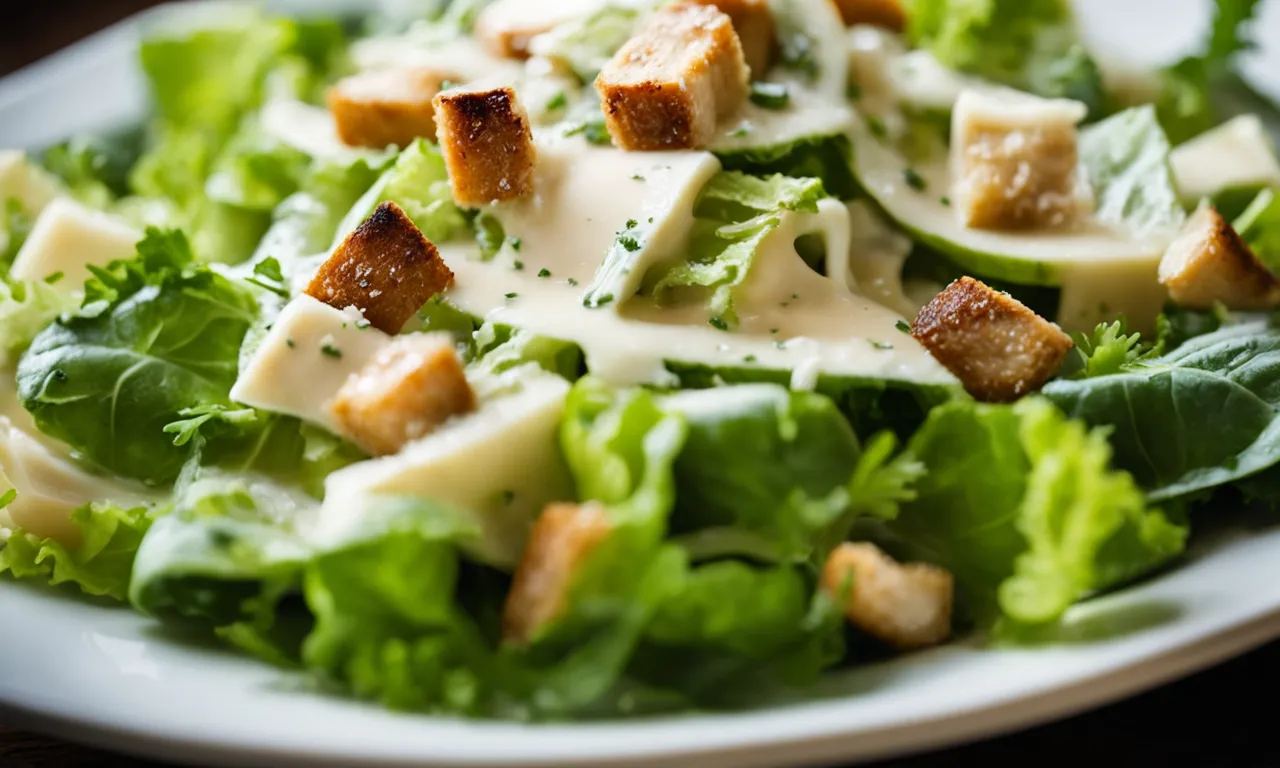Is Caesar Dressing Vegetarian? Examining The Ingredients
Caesar salad is a beloved staple menu item at many restaurants. But what about the creamy, tangy dressing that brings the salad to life – is Caesar dressing actually vegetarian?
If you’re short on time, here’s a quick answer to your question: Traditional Caesar dressing contains anchovies and Worcestershire sauce, so it is not vegetarian. However, some restaurants and brands make vegetarian Caesar dressings by omitting the non-vegetarian ingredients.
In this nearly 3000 word article, we’ll take a comprehensive look at Caesar dressing, its history and original recipe, examine the typical ingredients, and discuss how to order or make a vegetarian version of this iconic salad topper.
The Origins and History of Caesar Dressing
Caesar dressing is a popular salad dressing that is loved by many. But have you ever wondered about its origins and history? Let’s dive into the fascinating story behind this delicious dressing.
Invented in Tijuana in the 1920s
The story of Caesar dressing begins in the 1920s in Tijuana, Mexico. The invention of the dressing is credited to a chef named Caesar Cardini, who owned a restaurant in Tijuana. According to popular legend, Caesar Cardini created the dressing on the spot when he ran out of ingredients and needed to whip up something delicious for his hungry customers.
Caesar Cardini’s restaurant was a popular destination for Americans during the Prohibition era, as Tijuana was just a short drive from the border. The popularity of the dressing soon spread to the United States, where it became a staple in many restaurants and households.
The Original Recipe Called for Anchovies
While the exact recipe for Caesar dressing has evolved over the years, the original recipe called for anchovies. Anchovies are small saltwater fish that are commonly used in various cuisines for their unique and savory flavor.
Traditionally, Caesar dressing included mashed anchovies, garlic, lemon juice, Worcestershire sauce, Dijon mustard, olive oil, and Parmesan cheese. These ingredients combined to create a tangy and creamy dressing that complemented the crispness of the lettuce in a Caesar salad.
Caesar Dressing Became Popularized in Restaurants
As Caesar dressing gained popularity, it became a beloved dressing choice in restaurants across the United States. Its unique flavor profile and versatility made it a perfect accompaniment to a variety of salads and dishes.
Today, Caesar dressing can be found in almost every supermarket and is a staple in many households. While the original recipe called for anchovies, there are now vegetarian and vegan versions available that omit this ingredient.
These variations allow individuals with dietary restrictions or personal preferences to still enjoy the deliciousness of Caesar dressing.
Traditional Caesar Dressing Ingredients
Eggs and Oil Form the Emulsion
One of the key components of traditional Caesar dressing is the emulsion of eggs and oil. This combination creates a creamy and smooth texture that is characteristic of Caesar dressing. The eggs act as an emulsifying agent, helping to bind the oil and other ingredients together.
It’s important to note that the eggs used in Caesar dressing are typically raw, so if you have concerns about consuming raw eggs, it’s best to opt for a vegetarian or vegan version of Caesar dressing.
Parmesan Cheese and Garlic for Flavor
Another essential ingredient in Caesar dressing is Parmesan cheese. The cheese adds a rich and savory flavor to the dressing. However, it’s worth noting that some Parmesan cheeses are not vegetarian-friendly as they contain animal rennet, which is derived from the stomach lining of calves.
If you’re a vegetarian, look for a vegetarian-friendly alternative or make your own Caesar dressing using vegetarian Parmesan cheese.
In addition to Parmesan cheese, garlic is also commonly used in traditional Caesar dressing. The garlic adds a distinct and bold flavor to the dressing, enhancing its overall taste. Garlic is a versatile ingredient that is widely used in many cuisines, and its inclusion in Caesar dressing helps to elevate its flavor profile.
Anchovies Provide a Savory, Umami Flavor
One ingredient that may come as a surprise to some is anchovies. Anchovies are small, oily fish that are often used to add a savory and umami flavor to dishes. In traditional Caesar dressing, anchovies are typically used in the form of anchovy paste or anchovy fillets.
Their inclusion adds depth and complexity to the dressing, giving it that signature Caesar flavor.
If you’re a vegetarian or vegan, you may want to look for a Caesar dressing recipe that omits anchovies or uses a vegetarian alternative, such as capers or nutritional yeast, to achieve a similar umami flavor.
Worcestershire Sauce Contains Anchovies
Another ingredient commonly found in Caesar dressing is Worcestershire sauce. This tangy and flavorful sauce is made from a blend of various ingredients, including anchovies. Worcestershire sauce adds a unique taste to Caesar dressing, but it’s important to be aware of its anchovy content if you’re following a vegetarian or vegan diet.
If you’re looking for a vegetarian or vegan alternative to Worcestershire sauce, there are options available on the market that use plant-based ingredients to achieve a similar flavor profile.
Why Caesar Dressing is Not Traditionally Vegetarian
Caesar dressing is a popular and flavorful salad dressing that is loved by many. However, it is important to note that traditional Caesar dressing is not considered vegetarian. There are a couple of key reasons why this is the case.
Anchovies are a Type of Fish
One of the main reasons why Caesar dressing is not vegetarian is because it typically contains anchovies. Anchovies are a type of small, oily fish that are commonly used to add a savory and umami flavor to the dressing.
While some vegetarians may still consume fish, most strict vegetarians avoid it altogether. Therefore, the presence of anchovies in Caesar dressing makes it unsuitable for those following a vegetarian diet.
Some Worcestershire Sauces Also Contain Fish
In addition to anchovies, another ingredient commonly found in Caesar dressing that may not be vegetarian-friendly is Worcestershire sauce. This sauce is often used to enhance the flavor of the dressing and it typically contains anchovies or fish sauce as one of its ingredients.
This means that even if the dressing itself doesn’t contain visible pieces of fish, it may still have fish-derived ingredients in it.
It’s important for vegetarians to read the labels carefully and choose dressings that are specifically labeled as vegetarian or vegan. There are many alternatives available in the market that replicate the taste and texture of Caesar dressing without the use of animal products.
If you’re looking for more information on vegetarian and vegan options for dressings, websites like VegKitchen.com and VegetarianTimes.com offer a wide range of recipes and recommendations.
Ordering Vegetarian Caesar Dressing at Restaurants
Caesar dressing is a popular choice for many salad lovers, but if you’re a vegetarian, you may be wondering if it’s safe to enjoy. While traditional Caesar dressing contains anchovies, there are vegetarian-friendly alternatives available.
Here are some tips for ordering vegetarian Caesar dressing at restaurants:
Ask About Ingredients and Preparation
When dining out, it’s essential to ask your server about the ingredients in the Caesar dressing. Some restaurants may offer a vegetarian version that substitutes anchovies with ingredients like capers or miso paste. Others may have a completely vegan version made with plant-based ingredients.
By asking about the ingredients, you can ensure that your dressing is suitable for your dietary preferences.
Watch for Cross-Contamination
In some cases, restaurants may prepare their Caesar dressing on the same surfaces or with the same utensils used for non-vegetarian dressings. This can result in cross-contamination, making the dressing unsuitable for vegetarians.
To avoid this, it’s a good idea to inquire about the preparation process. If cross-contamination is a concern, you can ask for the dressing to be prepared separately or choose a different dressing option altogether.
Choose Dairy-Free Options
Another consideration for vegetarians is the use of dairy products in Caesar dressing. Traditional Caesar dressing often contains Parmesan cheese, which is not suitable for vegans or those with dairy allergies.
However, many restaurants now offer dairy-free versions of Caesar dressing that use ingredients like nutritional yeast or plant-based cheese substitutes. These options provide a similar taste and texture without the use of animal products.
Remember, it’s always a good idea to communicate your dietary preferences clearly to your server when ordering. By being proactive and asking about the ingredients and preparation methods, you can enjoy a delicious vegetarian Caesar salad without any concerns.
So, next time you’re dining out, don’t hesitate to ask about the dressing and make an informed choice that aligns with your vegetarian lifestyle!
How to Make Vegetarian Caesar Dressing at Home
Caesar dressing is a popular choice for salads and other dishes, but for those following a vegetarian diet, it’s important to ensure that the dressing is free of any animal products. Making your own vegetarian Caesar dressing at home is not only a great way to control the ingredients, but it also allows you to customize the flavors to your liking.
Here are some tips on how to make a delicious vegetarian Caesar dressing:
Substitute Nutritional Yeast for Parmesan
One of the key ingredients in traditional Caesar dressing is Parmesan cheese, which is not suitable for vegetarians. A great substitute for Parmesan is nutritional yeast, which has a cheesy, nutty flavor. Nutritional yeast is also a good source of B vitamins and protein, making it a healthy choice.
Simply add a couple of tablespoons of nutritional yeast to your dressing recipe to achieve that cheesy taste.
Use High-Quality Egg Replacements
Another non-vegetarian ingredient in Caesar dressing is raw egg yolk. To make a vegetarian version, you can use high-quality egg replacements that are made specifically for culinary purposes. These egg replacements are usually made from plant-based ingredients and can provide the same creamy texture as real eggs.
Look for egg replacers that are labeled as suitable for dressings or sauces, and follow the instructions on the package for the best results.
Experiment with Umami Flavor
One of the distinctive flavors of Caesar dressing comes from anchovies, which are not vegetarian-friendly. To achieve that umami flavor without using anchovies, you can experiment with other ingredients such as soy sauce, miso paste, or Worcestershire sauce.
These ingredients can add depth and richness to your dressing, giving it that satisfying umami taste. Start with small amounts and adjust to your preference.
Make Creamy Dairy-Free Version
If you’re not only vegetarian but also avoid dairy products, you can make a creamy dairy-free version of Caesar dressing. Instead of using traditional mayonnaise, you can use vegan mayonnaise made from plant-based oils.
There are many brands available on the market that offer dairy-free and egg-free mayonnaise options. Alternatively, you can make your own vegan mayonnaise using ingredients like aquafaba (the water from canned chickpeas) or silken tofu.
By following these tips, you can easily make a delicious vegetarian Caesar dressing at home that is free of any animal products. Whether you’re a vegetarian or simply looking for a healthier alternative, making your own dressing allows you to enjoy the flavors you love while staying true to your dietary choices.
Conclusion
While traditional Caesar dressing relies on anchovies for flavor, restaurants and home cooks can omit these fishy fillets and make delicious vegetarian and vegan versions. With the right egg and cheese substitutes, plus plenty of garlic, lemon, and herbs, it’s easy to recreate the tangy creaminess of Caesar dressing without the non-vegetarian ingredients.
At the end of the day, it’s smart for vegetarians to ask questions when dining out and read labels carefully when buying dressing from the store. But whether you’re cooking at home or eating out, there are now ample options to enjoy vegetarian Caesar dressing on your crisp romaine lettuce.







